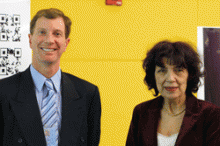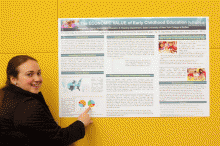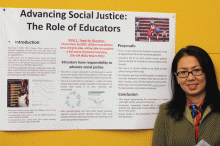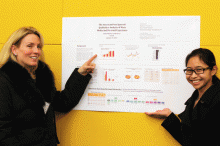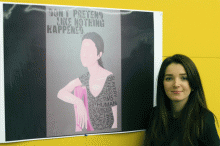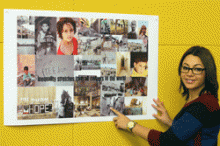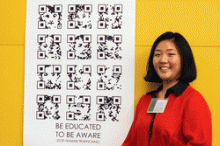2012 Winner
Two Best Practices Awards were presented during the 2013 Conference:
To Alpha Alpha State, Pennsylvania, of The Delta Kappa Gamma Society International (the Pennsylvania Chapter of Delta Kappa Gamma) for their Project “Hey, Sister Can you spare a PAIR?” which addressed the issue of young women unable to attend school during their menstrual cycles.
State President Louann Shrader, and Karen Bell, Projects Chair, accepted the award. Here is their description of the project:
“Alpha Alpha State strives to uphold the vision of the Society ‘Leading Women Educators Impacting Education Worldwide.’ The theme of the 2012 CTAUN Conference, ‘Education is a Human Right’ fit well with our vision and our support of Schools For Africa. This past year our state project titled, “Hey, Sister Can you spare a PAIR?” gave focus to Education as a Human Right and our need to strive to impact education globally.
In many African countries young women are denied the right to attend school during their menstrual cycle. For this reason girls fall further behind in their studies each month and eventually some of them drop out of school.
“Project Patricia”, a project that provides reusable feminine hygiene pads to young women in third world countries so they may attend school non stop each month is run by a group of women through a church in Kansas City, Missouri. However, when delivering the reusable pads to different countries a greater need was realized. The greater need was for proper undergarments to facilitate the use of the pads. Our project, ‘Hey Sister, Can you spare a PAIR?’, addressed this need.
With the help of the members of Alpha Alpha State and over a year’s time culminating with our state convention we collected over 3,800 pairs of cotton panties. What better way to ‘IMPACT Education Worldwide’ and assure young women the right to an education.”
and
To Lehigh University’s College of Education: Comparative and International Education Department for their project “Experiencing the United Nations” initiated by Professor Iveta Silova and International Outreach Director Bill Hunter. Bill Hunter accept the award and described the project:
Course: “Experiencing the United Nations”
“This graduate level course begins as classroom based learning and concludes with a unique experiential learning opportunity at the United Nations (UN) Commission on the Status of Women (CSW) annual conference.
Before attending the UN CSW conference, the class meets weekly to (1) lay a theoretical foundation for understanding key issues surrounding the broader topics of gender, education, and international development; (2) review existing UN policy documents on gender and development; as well as (3) analyze the role of the UN and NGOs in international agenda setting as related to gender equity in education. These theoretical readings and discussions laid the foundation for student engagement in the UN CSW conference.
At the CSW, Lehigh’s students serve as rapporteurs for the conference sessions, facilitate summary discussions among the delegates, and host a conference long (2-weeks) multilingual blog. The students have direct access to the Conference Chair and CSW Executive Board, keynote speakers, and engage with CSW delegates from around the world.
Students also conduct a research based survey of CSW NGO delegates attending the Women’s Celebration March, and host a CSW NGO session on our campus. The session is broadcast live to the UN and engages those NGO representatives who are unable to attend the UN CSW in person.
At the conclusion of the CSW, students are required to write a reflection paper, which provides an opportunity for the students to place their experiences at the UN in the context of theoretical readings and thus further engage with the issues of social equity and international development, specifically gender equity in national and international settings.
Coverage of the students’ blog and CSW experience can be found at: http://www4.lehigh.edu/news/newsarticle.aspx?Channel=/Channels/News:+2011&WorkflowItemID=03dd3c46-685b-4e76-97df-d999089a3311
Application guidelines for submitting a Best Practices Project based on past CTAUN conferences can be found on the BEST PRACTICES AWARDS tab on the left.
POSTER SESSION:
For the first time the CTAUN Conference invited college students to submit posters related to the conference topic. The winning entries were displayed in the conference room and the students were available for questions.
Here are the winners and their stories:
The Economic Value of Early Childhood Education by Margaret L. Henry, Buffalo State College
To see the full-size poster click here: EarlyChildhoodEd Poster
When you read the newspaper, open up a website, or just recently when listening to the presidential campaigns you were bombarded with the idea of a need to find the solution to a downtrodden economy. Meanwhile, the headlines are also covered with reports relating to budget cuts in schools, protesting teachers, teachers being laid off, or funding that has been cut. I suggest that we look at both these issues and question whether there is any correlation. Is the reason our economy has fallen because funding for education has dropped? Research has shown that we have been investing in the wrong capital; we need to invest in human capital. Human capital remains with a person and cannot be transferred from one person and given to another. Human capital is education. The most effective education begins before birth, but formal education only starts at age five. When students begin their education at age five, they have lost crucial years of their development: “Gaps in capabilities that play important roles in determining diverse adult outcomes originate before formal schooling begins and persist through childhood and into adulthood… schooling after the 2nd grade plays only a minor role in creating or reducing gaps” (Heckman, 2011, p. 34). Therefore, students who start their educational development at age five, when they are mandated by all the states, have started their formal education career at a disadvantage.
No education or poor education during the early childhood years results in disadvantaged students. These students end up creating the achievement gap that we currently see in schools. As U.S. Secretary of Education Arne Duncan (2011) states, “The best way to close the achievement gap is to start young- by closing the opportunity gap.” Education programs need to provide children and families with the opportunities to access education during the critical development period of a child’s life, in order to reverse the achievement gap.
Early Childhood Education programs are the right choice for the children and the right choice for the economy. Early educated students have a lesser chance for a need for future interventions that cost more money and are healthier individuals with developed cognitive, personality, and achievement skills. Ultimately, seven to nine cents per year is returned for every dollar spent on early childhood education. The American economic productivity is bound to increase with the economic investment of early childhood education programs across the nation.
As you can see, this issue has nothing to do with giving handouts to the low-income class who cannot afford early education programs; instead it has everything to do with the success of our nation’s economy and future generations. So, let us invest in our future, economy, human capital, and education, through supporting early childhood education programs across the nation!
Sources:
Duncan, A. (2011, April). The State of Preschool 2010. Speech presented at Oyster- Adams Bilingual School, Washington, D.C.
Heckman, J. (2011). The economics of inequality: The value of early childhood education. American Educator. 35(1), 31-47.
Advancing Social Justice: The Role of Educators by Penny Lu Pang, University of Bridgeport
To see the full-size poster click here: Poster-Role of Educators
The equal opportunity for education is a basic civil right which everyone deserves. But poverty has been one of the main factors that prevent students from attending school. According to the Millennium Development Goals Report 2011, there are still 67 million primary school age children all over the world deprived of education due to poverty. Economic inequality contributes to social injustices among the various classes and the regions of the world.
Educators have a responsibility to address such injustice. We may call for the UN and other international organizations to pay more attention to impoverished area where education is lacking. We may invoke international agencies and media and reinforce the monitoring of governments that do not enforce minimum education guidelines. We may work with social justice principles and socioeconomic incentives to ensure the primary school age children do go to school if their families are reluctant to support them. We also need to improve the cooperation between governments and NGOs in providing support for education of the impoverished and oppressed.
Advancing equality of education has profound significance. First, it will contribute to the rational use of social wealth through tax revenue and it will contribute to the sustainable development of the economy and of society. Secondly, since education is usually a dividing line for people between success and failure, we believe equality of education will change personal destinies and lives, thus furthering the development of the whole of society. Thirdly, improving education equality will improve social welfare. A wild range of social forces can contribute to remedying the defects of existing political and economic systems.
To conclude, economic inequality cannot be a reasonable pretext for depriving human beings of the right to an education. Social justice is the foundation of universal and lasting peace. Now is a time for a recommitment to achieving the second Millennium Development Goal of achieving universal primary education for boys and girls alike and then go beyond this to further opportunities for secondary and tertiary education as well.
Global impact of human trafficking or modern slavery by Ngwansi Nji, Baruch College, School of Public Affairs.
To see the full-size poster click here: Modern Slavery Around the World- Ngwansi Nji
The attached poster illustrates the global impact of human trafficking or modern slavery. My poster demonstrates the turmoil that victims of human  trafficking go through. In similar ways it is very much like being caught up in a tornado. The tornado here signifies the heinous crime of modern slavery. As a tornado spirals out of control, so is this crime against humanity. Most times victims such as the one on the poster are in bondage, both physically and mentally. They remain caught up in the eye of a storm that has devoured so many other innocent victims. Victims cry for help but nobody hears their cry because the tornado is too big and spiraling out of control. They are tagged and sold as you would merchandise at a department store, and disposed when their services are no longer needed.
trafficking go through. In similar ways it is very much like being caught up in a tornado. The tornado here signifies the heinous crime of modern slavery. As a tornado spirals out of control, so is this crime against humanity. Most times victims such as the one on the poster are in bondage, both physically and mentally. They remain caught up in the eye of a storm that has devoured so many other innocent victims. Victims cry for help but nobody hears their cry because the tornado is too big and spiraling out of control. They are tagged and sold as you would merchandise at a department store, and disposed when their services are no longer needed.
Human trafficking is a crime against humanity, a heinous crime that is present in every country of this world. The collage of flags surrounding the tornado signifies that every country is affected by modern slavery.
Modern slavery destroys lives. It is inhumane and unconstitutional. Therefore it is our responsibility as part of society to look out for one another. There is a storm brewing right now and we need to educate our communities, our states, our nation and the world about this new form of slavery.
Contents of the poster:
- A 14 yr old volunteer was recruited and photographed for the poster
- Each flag that makes up the collage was individually cut out and pasted on the poster
Sex trafficking: flourishing in the shadows by Moujan Shirazi-Moayed, Fordham University
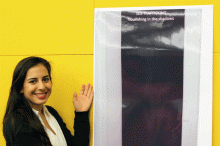 Article 4 of the Universal Declaration of Human rights prohibits slavery and slave trade in all their forms. However, almost 150 years after The Emancipation Proclamation signed by President Abraham Lincoln, human trafficking is one of the fastest growing criminal enterprises and is known today as the modern-day slavery.
Article 4 of the Universal Declaration of Human rights prohibits slavery and slave trade in all their forms. However, almost 150 years after The Emancipation Proclamation signed by President Abraham Lincoln, human trafficking is one of the fastest growing criminal enterprises and is known today as the modern-day slavery.
The Protocol to Prevent, Suppress and Punish Trafficking in Persons, especially Women and Children defines human trafficking as “the recruitment, transportation, transfer, harbouring or receipt of persons, by means of the threat or use of force or other forms of coercion, of abduction, of fraud, of deception, of the abuse of power or of a position of vulnerability or of the giving or receiving of payments or benefits to achieve the consent of a person having control over another person, for the purpose of exploitation.” This exploitation includes sexual exploitation which is a growing industry throughout the world. Although it also concerns men and adults, the majority of the victims of forced commercial sex acts are women and girls who are exploited through pornography, sex tourism or forced prostitution[i]. Sex trafficking is a flourishing business that generates billions of profits each year. Unfortunately, people know little about human trafficking in general and sex trafficking in particular.
Although sex trafficking mostly originates in impoverished countries where women are forced into prostitution or where poor families sell or exploit their child because they lack viable economic opportunities[ii], it is an illusion to think that this is what sex trafficking is all about. Sex trafficking is not isolated to a certain demographic; it is also a domestic illegal activity and people need to be more educated in this fast-growing issue that also happens within the U.S and other developed countries borders.
This is the aim of the documentary-video Slavery out of the Shadows: Spotlight on Human Trafficking, releasing in January, which deals with human trafficking in the state of Texas. For instance, it features the story of Debbie from San Antonio, whose mother sexually exploited her in exchange of drugs.[iii]
This is also the purpose of this poster: showing that sex trafficking flourishes at the international and domestic level in the shadows of public awareness, and public education is needed to tackle more efficiently this human rights infringement.
[i] “ 43% of victims [of human trafficking] are used for forced commercial sexual exploitation, of whom 98 per cent are women and girls” http://www.unglobalcompact.org/docs/issues_doc/labour/Forced_labour/HUMAN_TRAFFICKING_-_THE_FACTS_-_final.pdf
[ii] Katrin Corrigan, Putting the Brakes on the Global Trafficking of Women for the Sex Trade: An Analysis of Existing Regulatory Schemes to Stop the Flow of Traffic, 25 Fordham Int’l L.J. 151, 157 (2001)
[iii] Ty Meighan, Slavery Out of the Shadows: Spotlight on Human Trafficking, 75 Tex. B.J. 756, 758 (2012)
The American Poor Ignored by Anna Vors and Maureen Fitzpatrick, Dominican College


